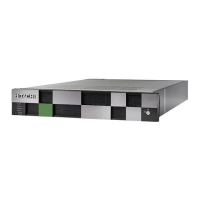
Do you have a question about the Hitachi SVP F 00 Series and is the answer not in the manual?
Identifies the target audience for the document, including administrators and service providers.
Explains typographic conventions and icons used throughout the document for clarity.
Provides a general introduction to the Service Processor (SVP) and its functions.
Describes the front panel of the physical SVP, including LEDs, reset, and power buttons.
Details the ports on the rear of the physical SVP, including power and LAN connections.
Lists the hardware specifications for the physical SVP running Windows 7.
Details the electrical specifications of the physical SVP, including dimensions and power.
Outlines the environmental requirements, such as temperature and humidity, for the physical SVP.
Describes the front panel of the physical SVP with Windows 10 Enterprise.
Details the ports on the rear of the physical SVP running Windows 10 Enterprise.
Lists the hardware specifications for the physical SVP running Windows 10 Enterprise.
Details the electrical specifications for the physical SVP with Windows 10 Enterprise.
Outlines the environmental requirements for the physical SVP with Windows 10 Enterprise.
Explains network bridging concepts for configuring the physical SVP.
Details the correct LAN port assignments on the physical SVP for connectivity.
Lists the default IP addresses and bridge configuration for SVP network interfaces.
Provides step-by-step instructions for installing the physical SVP into a rack.
Guides on how to physically mount the SVP in a rack, considering space and clearance.
Details how to select an appropriate location for mounting the physical SVP within a rack.
Describes the procedure to install the inner rack rail assembly onto the SVP chassis.
Explains how to attach the outer rack rails to the server rack for SVP installation.
Details how to connect the physical SVP to the network and management console.
Provides instructions on how to safely power on the physical SVP.
Guides on configuring the SVP for non-bridged network operation.
Explains how to configure the SVP's date, time, and time zone for accurate logging.
Lists hardware and OS requirements for installing SVP software on customer-provided servers.
Guides on setting SVP locale for languages other than English or Japanese.
Details initial operating system configuration steps for the SVP software.
Explains how to log in to the SVP's operating system using Remote Desktop.
Guides on adjusting Control Panel display settings for optimal usability.
Describes how to configure the Windows screen saver function on the SVP.
Details customizing the taskbar and start menu properties for the SVP.
Explains setting SVP time to UTC and disabling internet time synchronization.
Guides on setting region and language preferences for the SVP.
Details setting SVP power management to High Performance for optimum operation.
Instructs on disabling all settings within the Windows Action Center.
Guides on disabling the Windows Computer Maintenance setting.
Details necessary Windows firewall and remote settings for SVP access.
Explains configuring advanced, security, and properties settings for Internet Explorer.
Describes how to turn off the Windows AutoPlay feature for SVP security.
Guides on editing the Windows Registry using Regedit for SVP configuration.
Details enabling ICMP (ping) reply via Windows Firewall for SVP.
Explains how to change the SVP computer name for easy identification.
Guides on changing the user account name for the SVP.
Details configuring the Windows Administrator password for SVP use.
Explains how to change the password for the SVP's Windows operating system.
Guides on configuring Internet Information Services (IIS) for the SVP.
Describes the process of installing SVP software from an ISO image.
Illustrates the physical network connection for an Oracle Linux KVM-based SVP.
Lists prerequisites and minimum requirements for an Oracle Linux KVM SVP.
Verifies hyper-threading status for Oracle Linux KVM server and VM guest host.
Details configuration steps for the SVP in an Oracle Linux KVM environment.
Guides on setting SVP locale for languages other than English or Japanese.
Explains network connection ports for a virtual SVP.
Lists minimum requirements for running a virtual SVP on an ESX server.
Verifies hyper-threading status for ESXi server and VM guest host.
Details configuration steps for the virtual SVP on an ESXi host.
Describes configuration procedures for the SVP guest operating system.
Explains how to log on to the SVP guest OS using Remote Desktop.
Guides on adjusting Control Panel display settings for virtual SVP.
Describes configuring the Windows screen saver function for the virtual SVP.
Details customizing the taskbar and start menu for the virtual SVP.
Explains setting virtual SVP time to UTC and disabling internet time synchronization.
Guides on setting region and language preferences for the virtual SVP.
Details setting virtual SVP power management to High Performance.
Instructs on disabling all settings within the Windows Action Center for virtual SVP.
Guides on disabling Windows Computer Maintenance for virtual SVP.
Details necessary firewall and remote settings for virtual SVP access.
Explains IE advanced, security, and properties configuration for virtual SVP.
Describes how to turn off Windows AutoPlay for virtual SVP security.
Guides on editing the Windows Registry using Regedit for virtual SVP.
Details enabling ICMP (ping) reply via Windows Firewall for virtual SVP.
Explains changing the virtual SVP computer name for identification.
Guides on changing the user account name for the virtual SVP.
Details configuring the Administrator password for virtual SVP.
Explains changing the password for the virtual SVP's Windows OS.
Describes installing virtual SVP software from an ISO image.
Guides on setting SVP locale for languages other than English or Japanese.
Illustrates network connections for Hyper-V VM implementation.
Lists minimum requirements for running SVP on Hyper-V Server 2012 R2 VM.
Guides on installing and configuring Hyper-V on Windows 2012 R2 Server.
Details installing SVP software on a guest OS using Hitachi Device Manager.
Explains the procedure to stop services in storage systems before SVP upgrade.
Describes upgrading SVP software without affecting firmware or management software.
Details upgrading SVP, Device Manager, and storage system firmware simultaneously.
Explains how to stop the SVP service before performing an upgrade.
Guides on upgrading SVP software via the Storage Device List.
Explains applying security patches via automatic/manual Windows updates.
Guides on applying patches using downloaded stand-alone Microsoft packages.
Details how to install antivirus software on the SVP, considering performance impact.
Explains SSL protocol and related terms like keypair and server certificate.
Describes SSL encryption for three connection paths between system components.
Guides on creating private/public keys and uploading SSL certificates.
Details the process and considerations for updating the SVP server certificate.
Explains how to create a private key required for an SSL keypair.
Details how to create a public key required for an SSL keypair.
Describes methods to acquire a signed certificate for the private key.
Explains how to remove a passphrase from an SSL certificate before uploading.
Guides on converting SSL certificates to PKCS#12 format for upload.
Details uploading the signed certificate using the certificate update tool.
Explains uploading certificates for SSL communication with the web server.
Describes reverting the web server certificate to its default setting.
Guides on handling security certificate warnings during SSL sessions.
Details how to block outside access to the SVP's HTTP communication port.
Explains how to release a blocked HTTP port for SVP communication.
Guides on setting storage system IP addresses using the SVP maintenance utility.
Details how to edit storage system information within the Storage Device List.
Guides on changing SVP IP address via Windows 7 network settings.
Details changing SVP IP address via the Storage Device List.
Explains how to change SVP port numbers in supported applications and firewall settings.
Guides on resetting SVP port numbers to their initial settings.
Describes how to reassign automatically allocated port numbers to storage systems.
Explains how to initialize the range of automatically allocated port numbers.
Guides on changing the range of port numbers automatically allocated.
Explains how to view the port numbers currently in use by the SVP.
Modifies registry settings to handle STP BPDU guard on the network.
Guides on verifying and configuring IIS FTP settings.
Procedure to remove a registered storage system from the Storage Device List.
Details the process of registering a storage system onto the SVP.
Explains backing up SVP configuration to a USB drive for recovery.
Guides on restoring SVP configuration from a backup file.
Provides steps to safely shut down the SVP.
Details the procedure for restarting the SVP.
Outlines methods for detecting and resolving SVP failures.
Explains the process for replacing a physical SVP with a new unit.
Details using OSRT for recovering the SVP operating system.
Guides on backing up the operating system of the SVP.
Explains how to restore the operating system image for the SVP.
Details preparing a replacement physical SVP for operation.
Guides on assigning internal network adapters to Local Area Connection numbers.
Explains how to rename the internal SVP network adapters.
Guides on specifying IP addresses for SVP and storage system after adapter renaming.
Details configuring SVP for bridge mode by bridging network adapters.
Describes the procedure for installing the Hitachi Device Manager software.
Guides on identifying and resolving issues related to STP BPDU guard.
Provides steps for emergency logon to the SVP using the default IP address.












